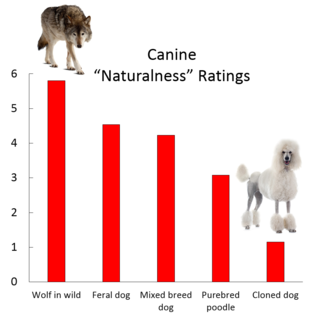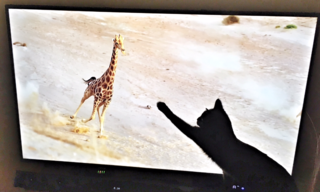Animal Behavior
Why Does Cloning Your Dog Just Seem Wrong?
New research helps explain why people oppose cloning pets.
Posted March 2, 2018

The other day, my wife and I got in argument about an article in the New York Times. It was about Barbra Streisand's decision to pay $50,000 to clone her dead dog, Samantha. The procedure was successful, and now she lives with a pair of cute puppies that carry Samantha’s genes.
“That’s disgusting,” Mary Jean told me.
“Why?” I said. “It’s her money. She’s got the dough.”
“Well,” she said, "everyone knows that the clones will not be identical to their mom.”
Playing the devil’s advocate, I said, “She's not dumb. She knew they would not be identical copies of Samantha. But she also knew that they will look a lot like her old dog, and they will probably have at least somewhat similar personalities.”
Mary Jean wasn’t buying it: “The puppies will be unhealthy and have genetic disorders. Remember Dolly the sheep? She was all messed up.”
“Not true,” I said. “Most of what you hear about Dolly is fake news. According to a paper published last year, Dolly was actually quite healthy. Further, researchers have extensively studied four cloned sheep from the same line as Dolly. They lived until the ripe old age of eight — that’s 70 in human years. And they did not have any health problems. Like it or not, animal cloning has come a long way. And according to an article I read in Science, the world’s best polo player now competes using a team of six cloned horses.”
I went on, “Korean researchers cloned the first dog in 2005. The pup, whom they named Snuppy, was perfectly healthy and died 13 days after his 10th birthday party. In fact, the same researchers also used a hot new gene splicing technique called CRISPR to produce Ruppy, a dog that glows red in the dark.”
“That’s creepy,” Mary Jean said. “We shouldn’t be producing animals with screwed-up genes.”
“I agree,” I said. “But a purebred French bulldog’s genes are way more screwed up than Snuppy’s. Have you seen the list of their health problems? They even have trouble eating and walking.”
Mary Jean took another track: “Well, instead of forking up all that money on clones, Streisand should have rescued a dog from the animal shelter.”
“Good point,” I said. “And a lot of people I greatly respect, including Alexandra Horowitz and Barbara King, agree with you. But while there are exceptions, I generally avoid imposing my values on other people. If you are opposed to abortion, then don’t get one. If you don’t believe in the consumption of animals, don’t eat meat. It’s the same with cloned puppies. If you are repulsed by the idea of a cloned pet, don’t clone your dog.”
I’m on a roll: “Now that I think about it, if cloned puppies are healthier and have more comfortable lives than, say, bulldogs, it’s hard to see what the big deal is with cloned pets.”
Then I asked her, “So, have I convinced you that Barbra Streisand is perfectly within her rights to fork out $50,000 on a cloned dog rather than send a big check to PETA?
“Nope,” she countered. “You’re wrong. Cloning animals is just, well, unnatural.”
Humans Have a “Natural Preference”
It was clear that I was not going to win our debate—and deep in my heart, I agreed with her. But why do most people find the idea of cloning so creepy? I think it is at least partly due to our deep-seated preference for natural things and our aversion to things that are unnatural.
The University of Pennsylvania food psychologist Paul Rozin argues that humans have a decidedly and possibly innate “natural preference.” That’s why we are so willing to pay more for “all-natural” meat and for “non-GMO” veggies. In a 2005 study, Rozin developed a method to investigate the degree to which various manipulations affect how people perceive the naturalness of foods. Take, for example, the effect on perceived naturalness of removing the fat from milk. In one study, Rozin's subjects rated the naturalness of various forms of milk on a scale from 0 (not at all natural) to 6 (completely natural). The percentage decline in naturalness caused by removing the fat from milk can then be calculated by subtracting the ratings of skim milk from organic milk and dividing the difference by the organic milk rating. Let’s say, for example, that organic milk gets a 6 and skim milk is rated as a 4. We would subtract 4 from 6 and divide by 6. In this case, the removal of fat caused a 33 percent decline in the perceived naturalness of the milk.
Appalachian State University social psychologist Chris Holden and I adapted Rozin’s methods to investigate how people perceive the naturalness of different kinds of animals, including dogs. We presented the results of our first study at the 2017 meeting of the International Society for Anthrozoology. We think they offer a window into the widespread aversion to cloning animals.
How “Natural” Is a Cloned Dog?
We recruited 137 participants through Amazon’s Mechanical Turk internet subject pool. They completed an online survey in which they evaluated the “naturalness” of 32 animals on Rozin’s 0 (not at all natural) to 6 (completely natural) scale. The creatures ranged from elephants living in an African jungle and elephants living in a zoo to indoor cats and outdoor cats. Five of the animals were canids — a wolf in the wild, an unowned (feral) dog living in a rural village, a mixed-breed pet dog, a purebred poodle, and a cloned dog.

As shown in this graph, the “perceived naturalness” ratings of the animals dropped precipitously from the wolf to the cloned dog.
But the effect of cloning shows up even more if we look at the percent declines in perceived naturalness caused by domestication and genetic engineering. As shown in this graph, our subjects perceived no difference in the naturalness of a mixed-breed pet dog and a feral dog living around a human village. On the other hand, a purebred poodle was perceived as 13 percent less natural than a mixed-breed dog, and a mixed-breed dog was viewed as 25 percent less natural than a wolf. But the big difference was caused by cloning. Our participants perceived the cloned dog as having lost about 70 percent of its “naturalness.” It just did not seem like a real dog any more.

Barbra Streisand’s Puppies and the Naturalistic Fallacy
I think Mary Jean’s visceral reaction to Streisand’s cloned puppies reflected the operation of a quick and dirty mental rule of thumb called a moral heuristic. In this case, it was the tendency to equate “natural” with “good” and “unnatural” with “bad.” Philosophers eagerly point out the problem with this line of thinking. Indeed, it has a name — the “naturalistic fallacy.” After all, they argue, infanticide, cannibalism, and the consumption of feces are surprising common in the natural world. On the other hand, eye glasses, vaccines, and organ transplants are decidedly unnatural.
While I hate to admit it, I’ve talked myself into thinking that Streisand is on firmer ethical grounds cloning Samantha than if she had purchased a pair of bulldog puppies.
What about the $50,000, you ask? I’m giving her a pass on that. After all, she’s donated more than $25 million to groups like the National Resources Defense Council. That counts for something.

However, despite our differences over genetic engineering, Mary Jean and I have agreed not to clone our cat, Tilly. Here she is going after a giraffe while we were watching Planet Earth II on TV.
Facebook image: Moriah Maddux/Shutterstock
References
Herzog, H. & Holden, C. (2017). Perceived “Naturalness” of Animals: The Impact of Domestication, Captivity, and Genetic Modification. Presentation at the meeting of the International Society for Anthrozoology, Davis, California.
Rozin, P. (2005). The meaning of “natural” process more important than content. Psychological science, 16(8), 652-658.
Kim, M. J., Oh, H. J., Kim, G. A., Setyawan, E. M. N., Choi, Y. B., Lee, S. H., & Lee, B. C. (2017). Birth of clones of the world’s first cloned dog. Scientific Reports, 7(1), 15235.




